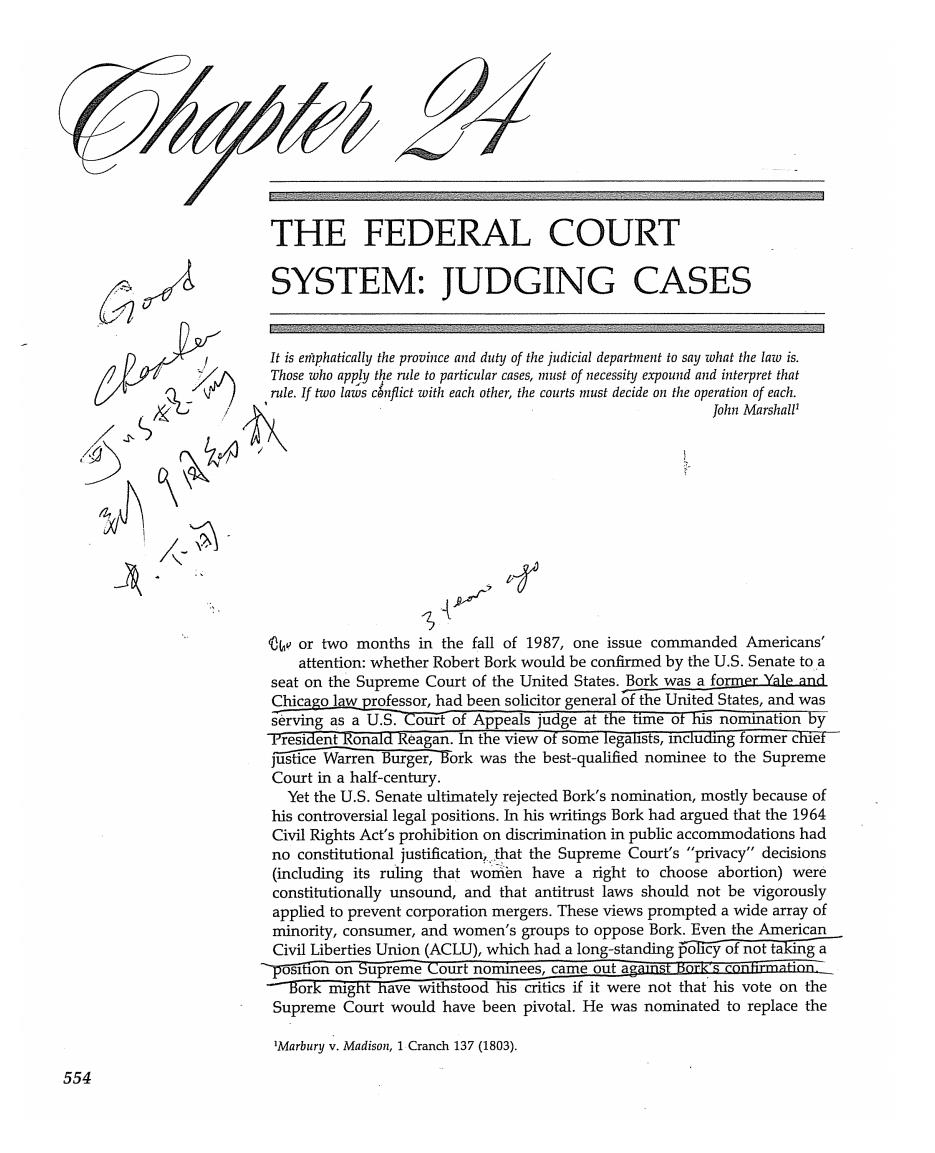
℃y THE FEDERAL COURT SYSTEM:JUDGING CASES It is emphatically the province and duty of the judicial department to say what the law is Those who apply the rule to particular cases,must of necessity expound and interpret that rule.If two laws conflict with each other,the courts must decide on the operation of each. John Marshall 小9风初 Cho or two months in the fall of 1987,one issue commanded Americans' attention:whether Robert Bork would be confirmed by the U.S.Senate to a seat on the Supreme Court of the United States.Bork was a former Yale and Chicago law professor,had been solicitor general of the United States,and was serving as a U.S.Court of Appeals judge at the time of his nomination by President Ronald Reagan.In the view of some legalists,including former chief justice Warren Burger,Bork was the best-qualified nominee to the Supreme Court in a half-century. Yet the U.S.Senate ultimately rejected Bork's nomination,mostly because of his controversial legal positions.In his writings Bork had argued that the 1964 Civil Rights Act's prohibition on discrimination in public accommodations had no constitutional justification,that the Supreme Court's "privacy"decisions (including its ruling that women have a right to choose abortion)were constitutionally unsound,and that antitrust laws should not be vigorously applied to prevent corporation mergers.These views prompted a wide array of minority,consumer,and women's groups to oppose Bork.Even the American Civil Liberties Union(ACLU),which had a long-standing policy of not taking a position on Supreme Court nominees,came out against bork's confirmation. Bork might have withstood his critics if it were not that his vote on the Supreme Court would have been pivotal.He was nominated to replace the Marbury v.Madison,1 Cranch 137 (1803). 554
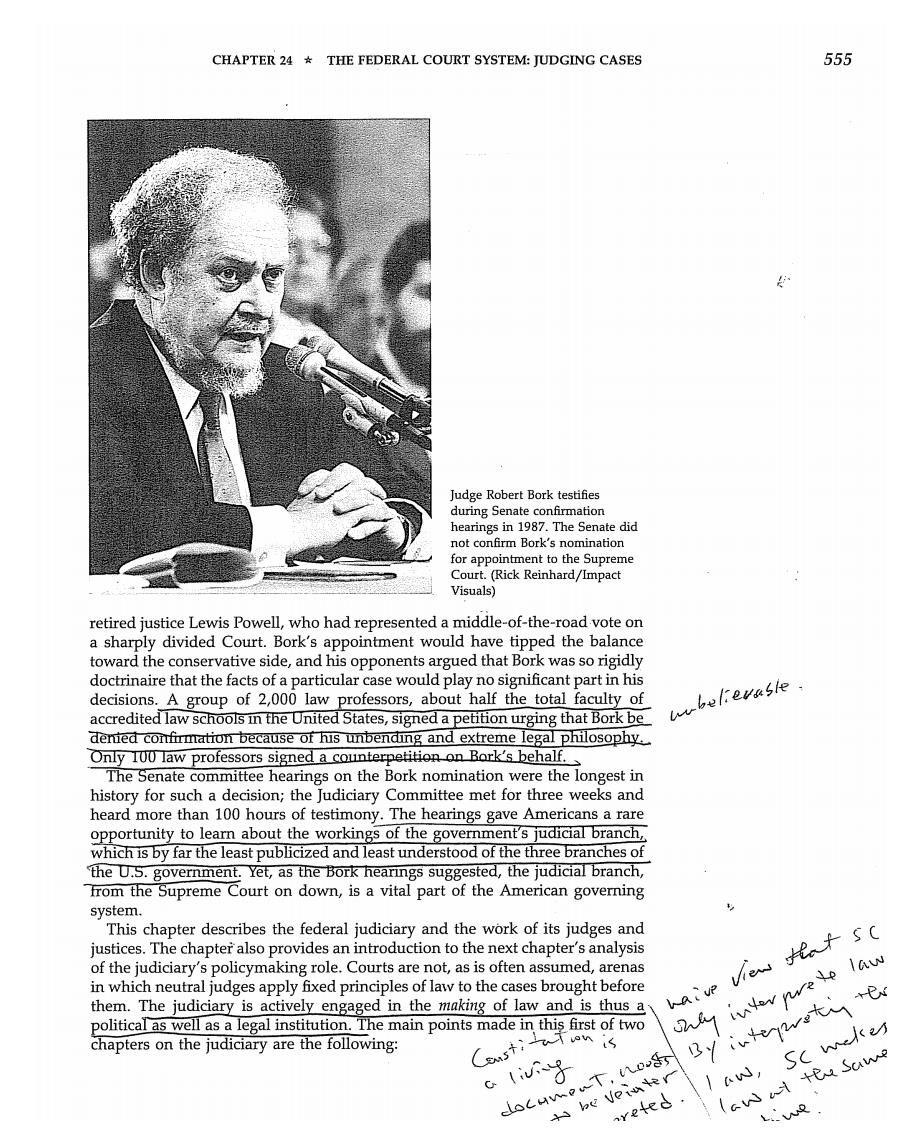
CHAPTER 24 THE FEDERAL COURT SYSTEM:JUDGING CASES 555 Judge Robert Bork testifies during Senate confirmation hearings in 1987.The Senate did not confirm Bork's nomination for appointment to the Supreme Court.(Rick Reinhard/Impact Visuals) retired justice Lewis Powell,who had represented a middle-of-the-road vote on a sharply divided Court.Bork's appointment would have tipped the balance toward the conservative side,and his opponents argued that Bork was so rigidly doctrinaire that the facts of a particular case would play no significant part in his decisions.A group of 2,000 law professors,about half the total faculty of accredited law schools in the United States,signed a petition urging that Bork be urbelevasle. denied confurmation because of his unbending and extreme legal philosophy. Only 100 law professors signed a counterpetition on Bork's behalf. The Senate committee hearings on the Bork nomination were the longest in history for such a decision;the Judiciary Committee met for three weeks and heard more than 100 hours of testimony.The hearings gave Americans a rare opportunity to learn about the workings of the government's judicial branch, which is by far the least publicized and least understood of the three branches of the U.S.government.Yet,as the Bork hearings suggested,the judicial branch, from the Supreme Court on down,is a vital part of the American governing system. This chapter describes the federal judiciary and the work of its judges and justices.The chapter also provides an introduction to the next chapter's analysis of the judiciary's policymaking role.Courts are not,as is often assumed,arenas in which neutral judges apply fixed principles of law to the cases brought before aue比大s( ivtw pwete law 小e them.The judiciary is actively engaged in the making of law and is thus a political as well as a legal institution.The main points made in this first of two chapters on the judiciary are the following: By ivtws m 。w子 T, Sc wekes +心Veiater clocumo refed laus i te sawe L.-wa
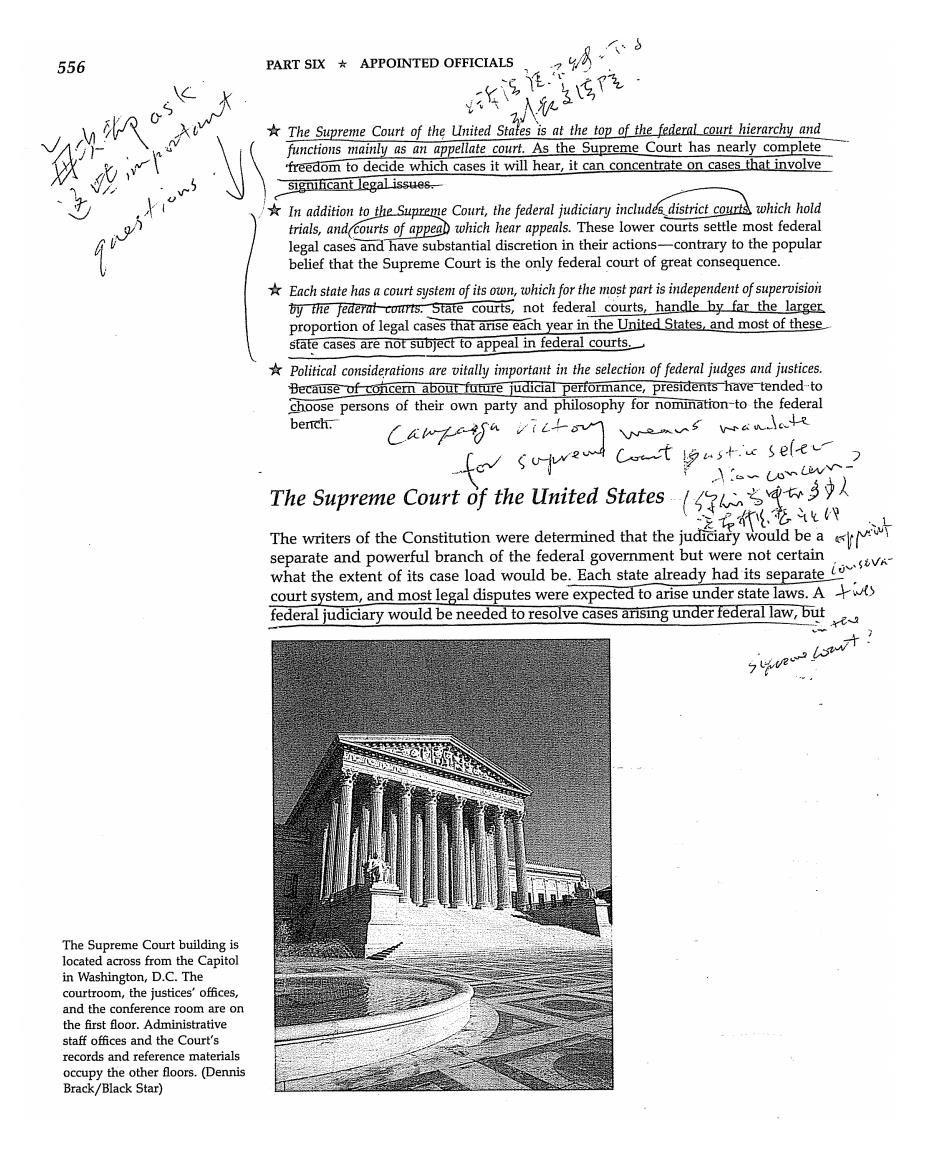
556 该泛尔减,下6 PART SIX APPOINTED OFFICIALS 小度 The Supreme Court of the United States is at the top of the federal court hierarchy and functions mainly as an appellate court.As the Supreme Court has nearly complete freedom to decide which cases it will hear,it can concentrate on cases that involve significant legal issues. *In addition to the Supreme Court,the federal judiciary includes district courts which hold trials,and courts of appeal which hear appeals.These lower courts settle most federal legal cases and have substantial discretion in their actions-contrary to the popular belief that the Supreme Court is the only federal court of great consequence. *Each state has a court system of its own,which for the most part is independent of supervision ty the federal comrts.State courts,not federal courts,handle by far the larger proportion of legal cases that arise each year in the United States,and most of these state cases are not subject to appeal in federal courts. Political considerations are vitally important in the selection of federal judges and justices. Because of concern about future judicial performance,presidents have tended to choose persons of their own party and philosophy for nomination-to the federal bench. 公cR o sumr®nCts+iw sele The Supreme Court of the united States 之云及竟州 Codereed that the流i治bea separate and powerful branch of the federal government but were not certain what theextent of its case load would be.Each state already hadtsepe court system,and most legal disputes were expected to arise under state laws.A federal judiciary would be needed to resolve cases arising under federal law,but +eg Hew心w才’ The Supreme Court building is located across from the Capitol in Washington,D.C.The courtroom,the justices'offices, and the conference room are on the first floor.Administrative staff offices and the Court's records and reference materials occupy the other floors.(Dennis Brack/Black Star)
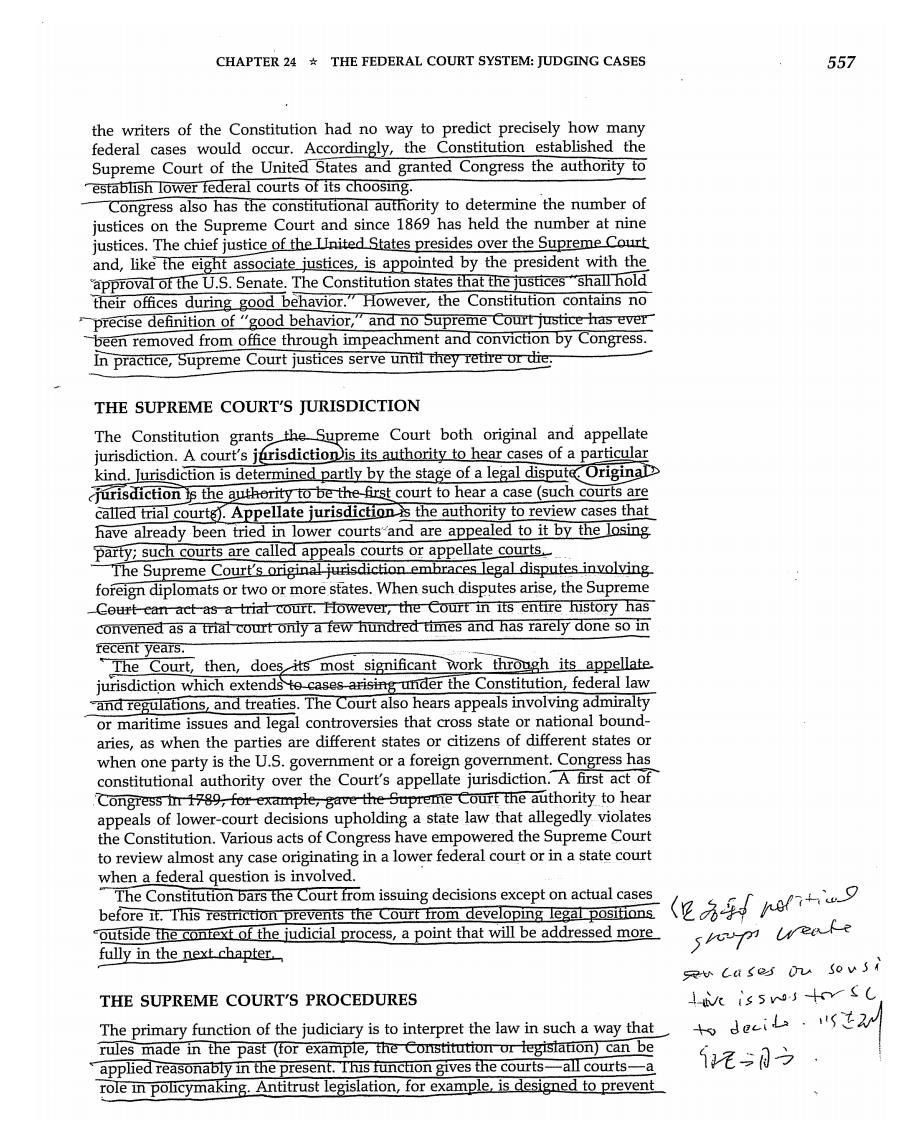
CHAPTER 24 THE FEDERAL COURT SYSTEM:JUDGING CASES 557 the writers of the Constitution had no way to predict precisely how many federal cases would occur.Accordingly,the Constitution established the Supreme Court of the United States and granted Congress the authority to establish lower federal courts of its choosing. Congress also has the constitutional authority to determine the number of justices on the Supreme Court and since 1869 has held the number at nine justices.The chief justice of the UInited States presides over the Supreme Court and,like the eight associate justices,is appointed by the president with the approval of the U.S.Senate.The Constitution states that the justices "shall hold their offices during good behavior."However,the Constitution contains no precise definition of "good behavior,"and no Supreme Court justice has ever been removed from office through impeachment and conviction by Congress. In practice,Supreme Court justices serve until they retire or die. THE SUPREME COURT'S JURISDICTION The Constitution grants the Supreme Court both original and appellate jurisdiction.A court's jarisdiction is its authority to hear cases of a particular kind.Jurisdiction is determined partly by the stage of a legal dispute.Original jurisdiction is the authority to be the first court to hear a case(such courts are called trial courte).Appellate jurisdiction is the authority to review cases that have already been tried in lower courts and are appealed to it by the losing party;such courts are called appeals courts or appellate courts. The Supreme Court's original jurisdiction embraces legal disputes involving foreign diplomats or two or more states.When such disputes arise,the Supreme Court can act as a trial court.However,the Court in its entire history has convened as a trial court only a few hundred times and has rarely done so in recent years. The Court,then,does its most significant work through its appellate jurisdiction which extends te-cases-arising under the Constitution,federal law and regulations,and treaties.The Court also hears appeals involving admiralty or maritime issues and legal controversies that cross state or national bound- aries,as when the parties are different states or citizens of different states or when one party is the U.S.government or a foreign government.Congress has constitutional authority over the Court's appellate jurisdiction.A first act of Congress in 1789,for-example,gave the-Supreme Court the authority to hear appeals of lower-court decisions upholding a state law that allegedly violates the Constitution.Various acts of Congress have empowered the Supreme Court to review almost any case originating in a lower federal court or in a state court when a federal question is involved. The Constitution bars the Court from issuing decisions except on actual cases before it.This restriction prevents the Court from developing legal positions. (ea到人+可 outside the context of the judicial process,a point that will be addressed more mLwe人e fully in the next chapter. 元ucase0ou5 THE SUPREME COURT'S PROCEDURES Li isswstorsc The primary function of the judiciary is to interpret the law in such a way that rules made in the past (for example,the Constitution or legislation)can be applied reasonably in the present.This function gives the courts-all courts-a 元-月→ role in policymaking.Antitrust legislation,for example,is designed to prevent
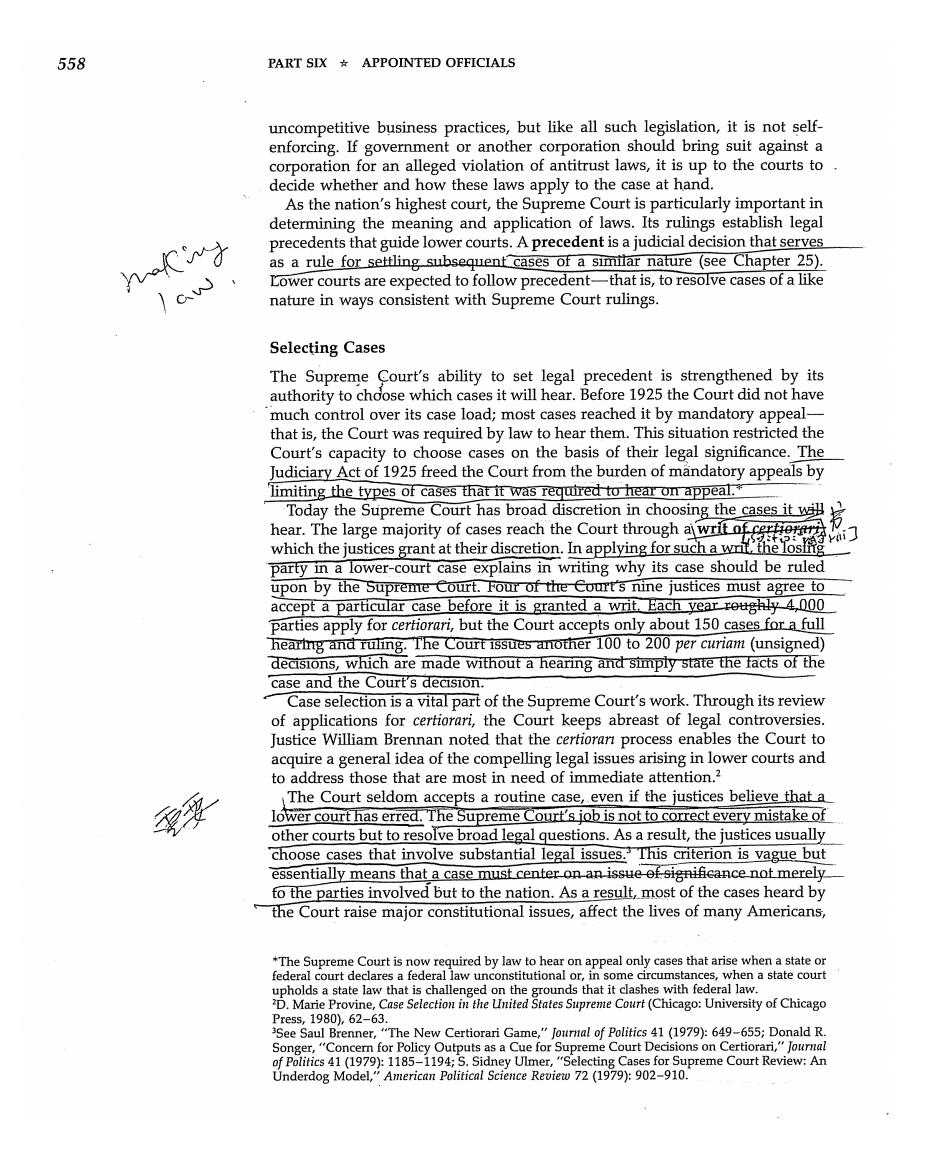
558 PART SIX APPOINTED OFFICIALS uncompetitive business practices,but like all such legislation,it is not self- enforcing.If government or another corporation should bring suit against a corporation for an alleged violation of antitrust laws,it is up to the courts to decide whether and how these laws apply to the case at hand. As the nation's highest court,the Supreme Court is particularly important in determining the meaning and application of laws.Its rulings establish legal 才 precedents that guide lower courts.A precedent is a judicial decision that serves as a rule for settling subsequent cases of a similar nature (see Chapter 25). Cw Lower courts are expected to follow precedent-that is,to resolve cases of a like nature in ways consistent with Supreme Court rulings Selecting Cases The Supreme Court's ability to set legal precedent is strengthened by its authority to chdose which cases it will hear.Before 1925 the Court did not have much control over its case load;most cases reached it by mandatory appeal- that is,the Court was required by law to hear them.This situation restricted the Court's capacity to choose cases on the basis of their legal significance.The Judiciary Act of 1925 freed the Court from the burden of mandatory appeals by limiting the types of cases that it was required to hear on appeal. Today the Supreme Court has broad discretion in choosing the cases it will hear.The large majority of cases reach the Court through a writ of certerr 4 which the justices grant at their discretion.In applying for such a writ the losiig party in a lower-court case explains in writing why its case should be ruled upon by the Supreme Court.Four of the Court's nine justices must agree to accept a particular case before it is granted a writ.Each year roughly 4,000 parties apply for certiorari,but the Court accepts only about 150 cases for a full hearing and ruling.The Court issues another 100 to 200 per curiam(unsigned) decisions,which are made without a hearing and simply state the facts of the case and the Court's decision. Case selection is a vital part of the Supreme Court's work.Through its review of applications for certiorari,the Court keeps abreast of legal controversies. Justice William Brennan noted that the certiorant process enables the Court to acquire a general idea of the compelling legal issues arising in lower courts and to address those that are most in need of immediate attention.? The Court seldom accepts a routine case,even if the justices believe that a_ 州 lower court has erred.The Supreme Court's job is not to correct every mistake of other courts but to resolve broad legal questions.As a result,the justices usually choose cases that involve substantial legal issues.This criterion is vague but essentially means that a case must center on an issue of significance not merely fo the parties involved but to the nation.As a result,most of the cases heard by the Court raise major constitutional issues,affect the lives of many Americans, *The Supreme Court is now required by law to hear on appeal only cases that arise when a state or federal court declares a federal law unconstitutional or,in some circumstances,when a state court upholds a state law that is challenged on the grounds that it clashes with federal law. D.Marie Provine,Case Selection in the United States Supreme Court(Chicago:University of Chicago Press,1980),62-63. 3See Saul Brenner,"The New Certiorari Game,"Journal of Politics 41(1979):649-655;Donald R. Songer,"Concern for Policy Outputs as a Cue for Supreme Court Decisions on Certiorari,"Journal of Politics 41 (1979):1185-1194:S.Sidney Ulmer,"Selecting Cases for Supreme Court Review:An Underdog Model,"American Political Science Review 72(1979):902-910
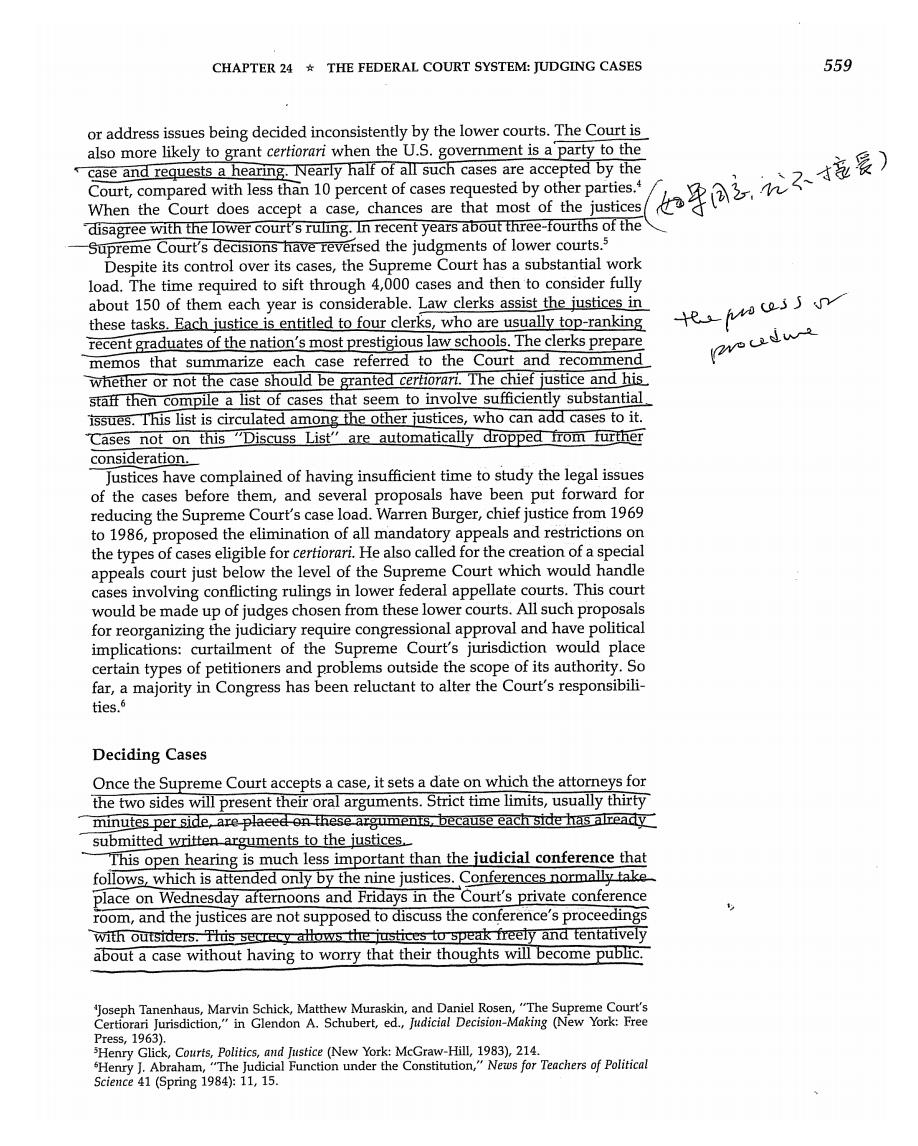
CHAPTER 24 THE FEDERAL COURT SYSTEM:JUDGING CASES 559 or address issues being decided inconsistently by the lower courts.The Court is also more likely to grant certiorari when the U.S.government is a party to the case and requests a hearing.Nearly half of all such cases are accepted by the Court,compared with less than 10 percent of cases requested by other parties. When the Court does accept a case,chances are that most of the justices 学a名,不寸意爱) disagree with the lower court's ruling.In recent years about three-fourths of the Supreme Court's decisions have reversed the judgments of lower courts.5 Despite its control over its cases,the Supreme Court has a substantial work load.The time required to sift through 4,000 cases and then to consider fully about 150 of them each year is considerable.Law clerks assist the justices in these tasks.Each justice is entitled to four clerks,who are usually top-ranking 代ofivo cass v recent graduates of the nation's most prestigious law schools.The clerks prepare rocdu memos that summarize each case referred to the Court and recommend whether or not the case should be granted certiorari.The chief justice and his staff then compile a list of cases that seem to involve sufficiently substantial issues.This list is circulated among the other justices,who can add cases to it. Cases not on this "Discuss List"are automatically dropped from further consideration. Justices have complained of having insufficient time to study the legal issues of the cases before them,and several proposals have been put forward for reducing the Supreme Court's case load.Warren Burger,chief justice from 1969 to 1986,proposed the elimination of all mandatory appeals and restrictions on the types of cases eligible for certiorari.He also called for the creation of a special appeals court just below the level of the Supreme Court which would handle cases involving conflicting rulings in lower federal appellate courts.This court would be made up of judges chosen from these lower courts.All such proposals for reorganizing the judiciary require congressional approval and have political implications:curtailment of the Supreme Court's jurisdiction would place certain types of petitioners and problems outside the scope of its authority.So far,a majority in Congress has been reluctant to alter the Court's responsibili- ties.6 Deciding Cases Once the Supreme Court accepts a case,it sets a date on which the attorneys for the two sides will present their oral arguments.Strict time limits,usually thirty minutes per side,are placed on these arguments,because each side has already submitted written arguments to the justices. This open hearing is much less important than the judicial conference that follows,which is attended only by the nine justices.Conferences normally take place on Wednesday afternoons and Fridays in the Court's private conference room,and the justices are not supposed to discuss the conference's proceedings with outsiders.This secrecy allows the justices to speak freely and tentatively about a case without having to worry that their thoughts will become public. Joseph Tanenhaus,Marvin Schick,Matthew Muraskin,and Daniel Rosen,"The Supreme Court's Certiorari Jurisdiction,"in Glendon A.Schubert,ed.,Judicial Decision-Making (New York:Free Press,1963). SHenry Glick,Courts,Politics,and Justice (New York:McGraw-Hill,1983),214. Henry J.Abraham,"The Judicial Function under the Constitution,"News for Teachers of Political Science 41 (Spring 1984):11,15
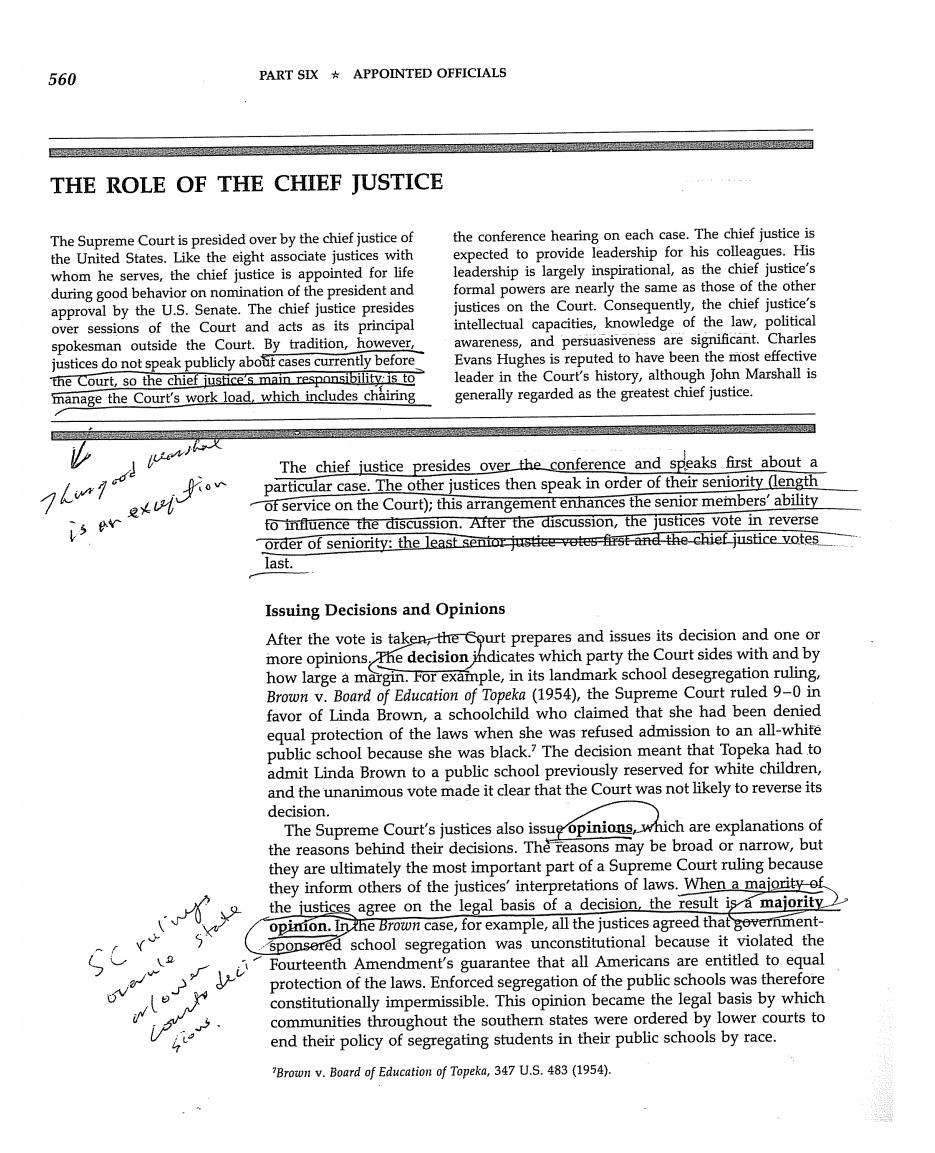
560 PART SIX APPOINTED OFFICIALS THE ROLE OF THE CHIEF JUSTICE The Supreme Court is presided over by the chief justice of the conference hearing on each case.The chief justice is the United States.Like the eight associate justices with expected to provide leadership for his colleagues.His whom he serves,the chief justice is appointed for life leadership is largely inspirational,as the chief justice's during good behavior on nomination of the president and formal powers are nearly the same as those of the other approval by the U.S.Senate.The chief justice presides justices on the Court.Consequently,the chief justice's over sessions of the Court and acts as its principal intellectual capacities,knowledge of the law,political spokesman outside the Court.By tradition,however, awareness,and persuasiveness are significant. Charles justices do not speak publicly about cases currently before Evans Hughes is reputed to have been the most effective the Court,so the chief justice's main responsibility:is to leader in the Court's history,although John Marshall is manage the Court's work load,which includes chairing generally regarded as the greatest chief justice. The chief justice presides over the conference and speaks first about a particular case.The other justices then speak in order of their seniority (length of service on the Court);this arrangement enhances the senior members'ability fo influence the discussion.After the discussion,the justices vote in reverse order of seniority:the least senior justice-votes-first and the chief justice votes last. Issuing Decisions and Opinions After the vote is taken,the Court prepares and issues its decision and one or more opinions,The decision indicates which party the Court sides with and by how large a margin.For example,in its landmark school desegregation ruling, Brown v.Board of Education of Topeka(1954),the Supreme Court ruled 9-0 in favor of Linda Brown,a schoolchild who claimed that she had been denied equal protection of the laws when she was refused admission to an all-white public school because she was black.?The decision meant that Topeka had to admit Linda Brown to a public school previously reserved for white children, and the unanimous vote made it clear that the Court was not likely to reverse its decision. The Supreme Court's justices also issue opinions,which are explanations of the reasons behind their decisions.The reasons may be broad or narrow,but they are ultimately the most important part of a Supreme Court ruling because they inform others of the justices'interpretations of laws.When a majority of 9 the justices agree on the legal basis of a decision,the result is a majority opinion.In the Brown case,for example,all the justices agreed that government- sponsered school segregation was unconstitutional because it violated the oLeule 久ci Fourteenth Amendment's guarantee that all Americans are entitled to equal protection of the laws.Enforced segregation of the public schools was therefore Couh constitutionally impermissible.This opinion became the legal basis by which communities throughout the southern states were ordered by lower courts to end their policy of segregating students in their public schools by race. "Brown v.Board of Education of Topeka,347 U.S.483 (1954)

CHAPTER 24 THE FEDERAL COURT SYSTEM:JUDGING CASES 561 When the chief justice votes with the majority,he decides which of the justices will write the majority opinion.Otherwise,the senior justice in the majority determines the author.Chief justices have often given themselves the influential task of writing the majority opinion in important cases.John Marshall did so often:Marbury v.Madison (1802)and McCulloch v.Maryland (1819)were among the opinions he wrote. The justice who writes the Court's majority opinion has an important and difficult job,since the other justices who voted with the majority must agree with the written opinion.Because the vote on a case is not considered final until the decision is made public,plenty of compromising and old-fashioned horse-trading can take place during the writing stage.The majority opinion often goes through a series of drafts and is circulated among all nine justices.In Brown v.Board of Education,Justice Felix Frankfurter,the lone initial holdout,was persuaded to make the decision unanimous by the continued urgings of his colleagues and by their willingness to incorporate some of his concerns into the majority opinion. In some cases there is no majority opinion because a majority of the justices agree on the decision but cannot agree on the legal basis for it.The result is a plurality opinion,which presents the view held by mest of the justices who side with the winning party.In the Bakke case (discussed in Chapter 6),the Court ruled 5-4 that Alan Bakke,a white male,had been wrongly denied admission to medical school because of a quota system that reserved a certain number of admissions for minority students.However,the five justices who ruled in Bakke's favor were divided in their legal reasoning.Four of the justices concluded that Bakke's denial of admission was a violation of the 1964 Civil Rights Act;their view became the plurality opinion.Lewis Powell,the fifth justice who sided with Bakke,believed that Bakke's denial of admission violated a constitutional right.Powell set forth his reasoning in a concurring opinion, which is a separate opinion written by a justice who votes with the majority but disagrees with their reasoning. A justice or justices on the losing side can write a dissenting opinion to explain their reasons for disagreeing with the majority position.Sometimes these dissents become a later Court's majority position.In a 1942 dissenting opinion,Justice Hugo Black wrote that defendants in state felony trials should have legal counsel,even if they could not afford to pay for it.Two decades later, in Gideon v.Wainwright(1963),the Court adopted this position.8 The American Judicial System During the Senate Judiciary Committee's confirmation hearings on Robert Bork, one of his supporters,Senator Gordon Humphrey(R-N.H.),became exasperat- ed by the line of questioning being pursued by senators who opposed Bork. Noting that the Judiciary Committee had scrutinized Bork five years earlier when he was nominated for a lower-court appointment,Humphrey asked why certain objections to Bork had not been raised back then.Humphrey was particularly incensed by criticisms of legal positions that Bork had taken in lectures and articles written long before he had entered the federal judiciary.If Gideon v.Wainwright,372 U.S.335(1963)

562 PART SIX APPOINTED OFFICIALS TYPES OF SUPREME COURT OPINIONS Majority opinion:a written opinion of the majority of the justices who support the majority position but disagree Court's justices stating the reasoning underlying their with the majority's reasoning on a case.This opinion decision on a case. expresses the reasoning of the concurring justices. Plurality opinion:a written opinion that in the absence of Dissenting opinion:a written opinion of one or more a majority opinion presents the reasoning of most of the justices who disagree with the majority's decision and justices who side with the winning party. opinion.This opinion provides the reasoning underlying Concurring opinion:a written opinion of one or more the dissent. Bork's earlier views were so questionable,Humphrey asked,why had they not been probed in the earlier hearings?Bork's opponents on the Senate Judiciary Committee ignored Humphrey's complaint,probably because they believed 九++&。 that the answer was obvious:a nominee to the Supreme Court needs much closer scrutiny than a lower-court nominee.After all,there are more than 100 tat-wikcoo 人 federal courts but there is only one Supreme Court,and its position at the top of the country's judicial system gives Supreme Court appointments unparalleled dite importance. It is a mistake,however,to conclude that the Supreme Court is the only court of consequence.Justice Jerome Frank once wrote of the"upper-court myth"that appellate courts and in particular the Supreme Court are the only truly significant judicial arena and that lower courts just dutifully follow the rulings handed down by the appellate level.The reality is very different,as the following discussion will explain. FEDERAL DISTRICT COURTS The lowest federal courts are the district courts(see Figure 24-1).There are more than ninety federal district courts altogetherat least one in every state and as many as four in some states.District-court judges,who number about 500 in all, are appointed by the president with the consent of the Senate. Federal cases usually originate in district courts,which are trial courts,where the parties present their evidence and argue their sides and a decision is rendered in favor of one party or the other.District courts are the only courts in the federal system in which juries hear testimony in some cases,and most cases at this level are presented before a single judge.Some district-court cases involve issues of "private law"(relationships between individuals and between businesses),such as divorce and contract disputes.Other cases involve issues of "public law"(relationships of individuals to government and the rights and obligations of each),such as crimes,political rights,and the government's obligations under the Constitution and under statutes and administrative regulations. From a letter to the author by Frank Schwartz of Beaver College,1986.This section reflects substantially Professor Schwartz's recommendations to the author,as does the later section that addresses the "federal-court myth
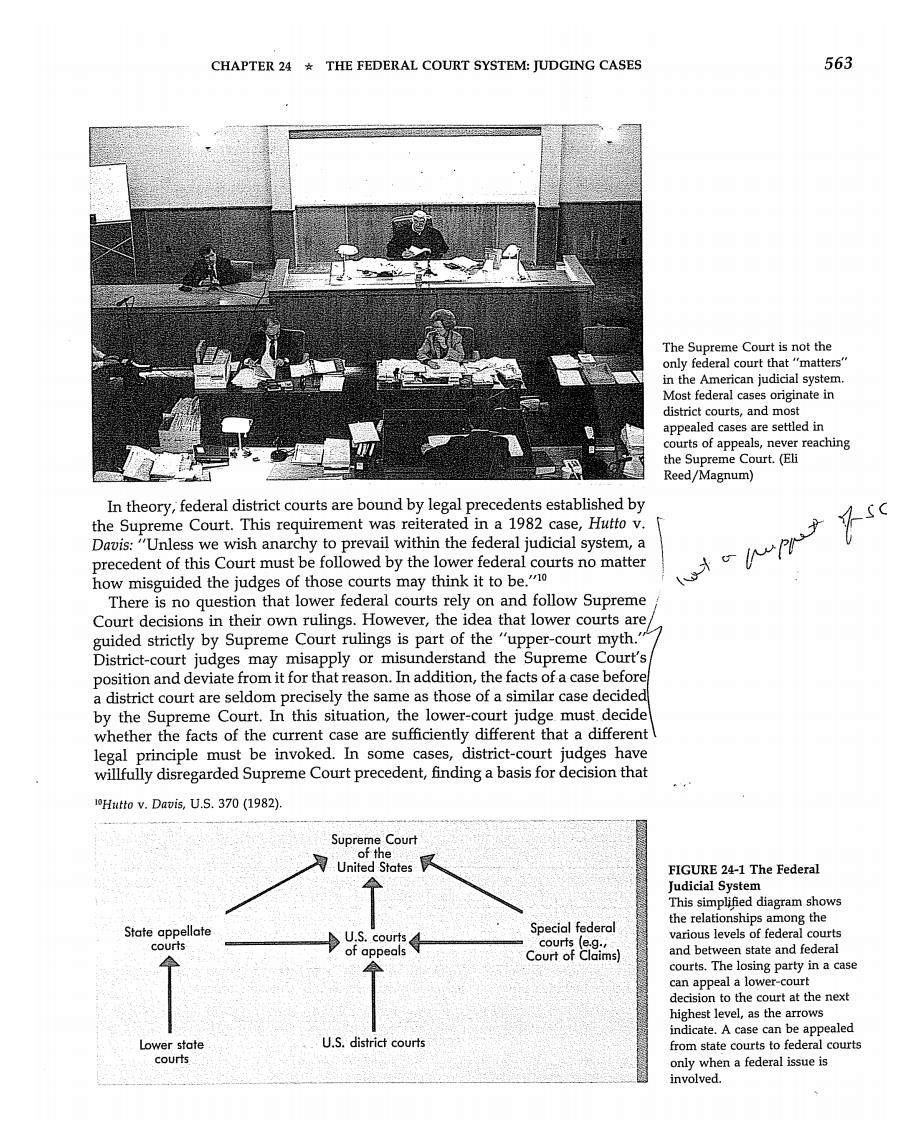
CHAPTER 24 THE FEDERAL COURT SYSTEM:JUDGING CASES 563 The Supreme Court is not the only federal court that"matters" in the American judicial system Most federal cases originate in district courts,and most appealed cases are settled in courts of appeals,never reaching the Supreme Court.(Eli Reed/Magnum) In theory,federal district courts are bound by legal precedents established by the Supreme Court.This requirement was reiterated in a 1982 case,Hutto v. Davis:"Unless we wish anarchy to prevail within the federal judicial system,a precedent of this Court must be followed by the lower federal courts no matter how misguided the judges of those courts may think it to be."10 There is no question that lower federal courts rely on and follow Supreme Court decisions in their own rulings.However,the idea that lower courts are guided strictly by Supreme Court rulings is part of the "upper-court myth." District-court judges may misapply or misunderstand the Supreme Court's position and deviate from it for that reason.In addition,the facts of a case before a district court are seldom precisely the same as those of a similar case decided by the Supreme Court.In this situation,the lower-court judge must.decide whether the facts of the current case are sufficiently different that a different legal principle must be invoked.In some cases,district-court judges have willfully disregarded Supreme Court precedent,finding a basis for decision that 1Hutto v.Davis,U.S.370 (1982). Supreme Court of the 月Unifed States FIGURE 24-1 The Federal Judicial System This simplified diagram shows the relationships among the State appellate U.S.courts Special federal courts (e.g.. various levels of federal courts courts of appeals Court of Claims) and between state and federal courts.The losing party in a case can appeal a lower-court decision to the court at the next highest level,as the arrows indicate.A case can be appealed Lower state U.S.district courts from state courts to federal courts courts only when a federal issue is involved